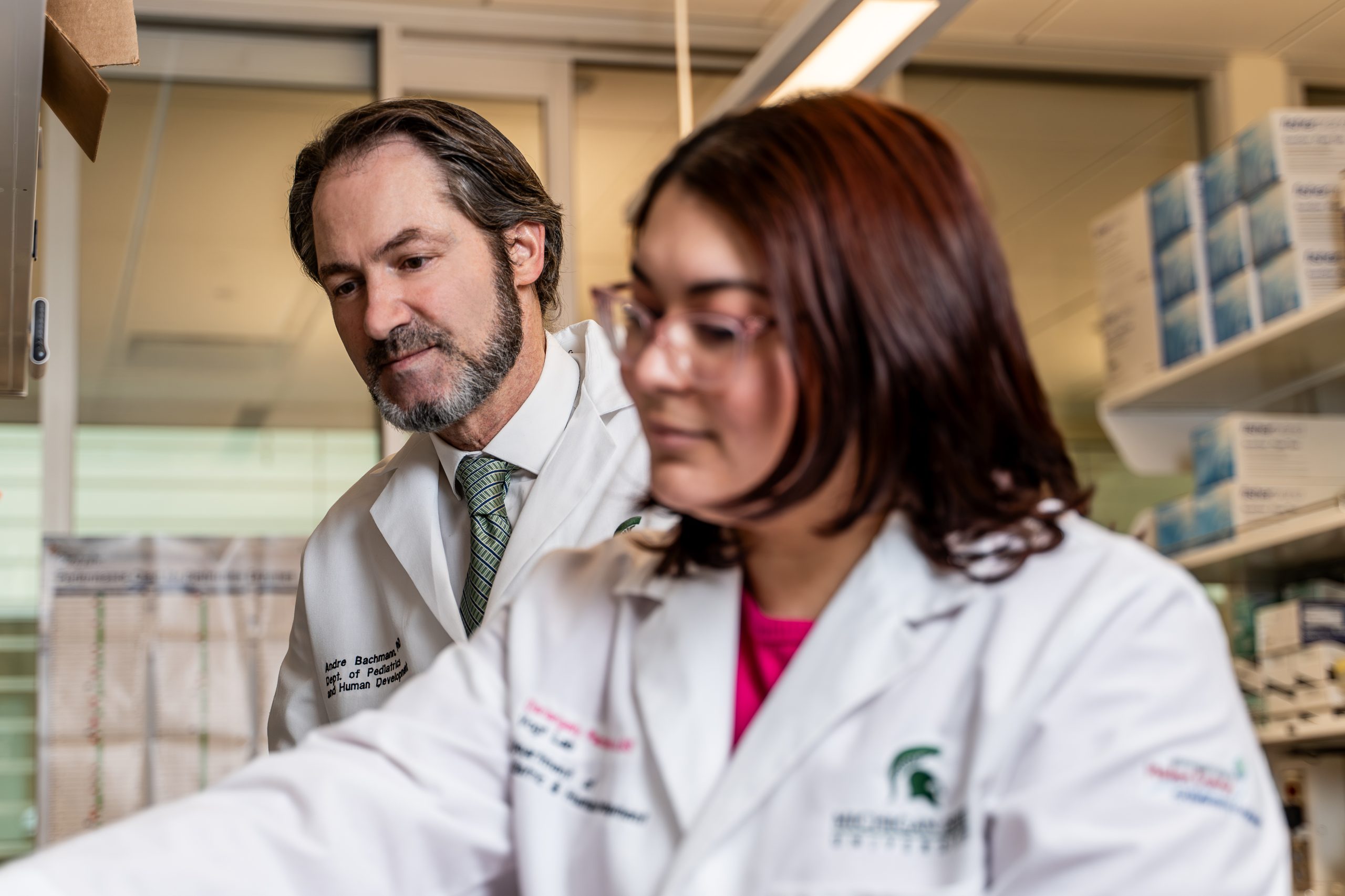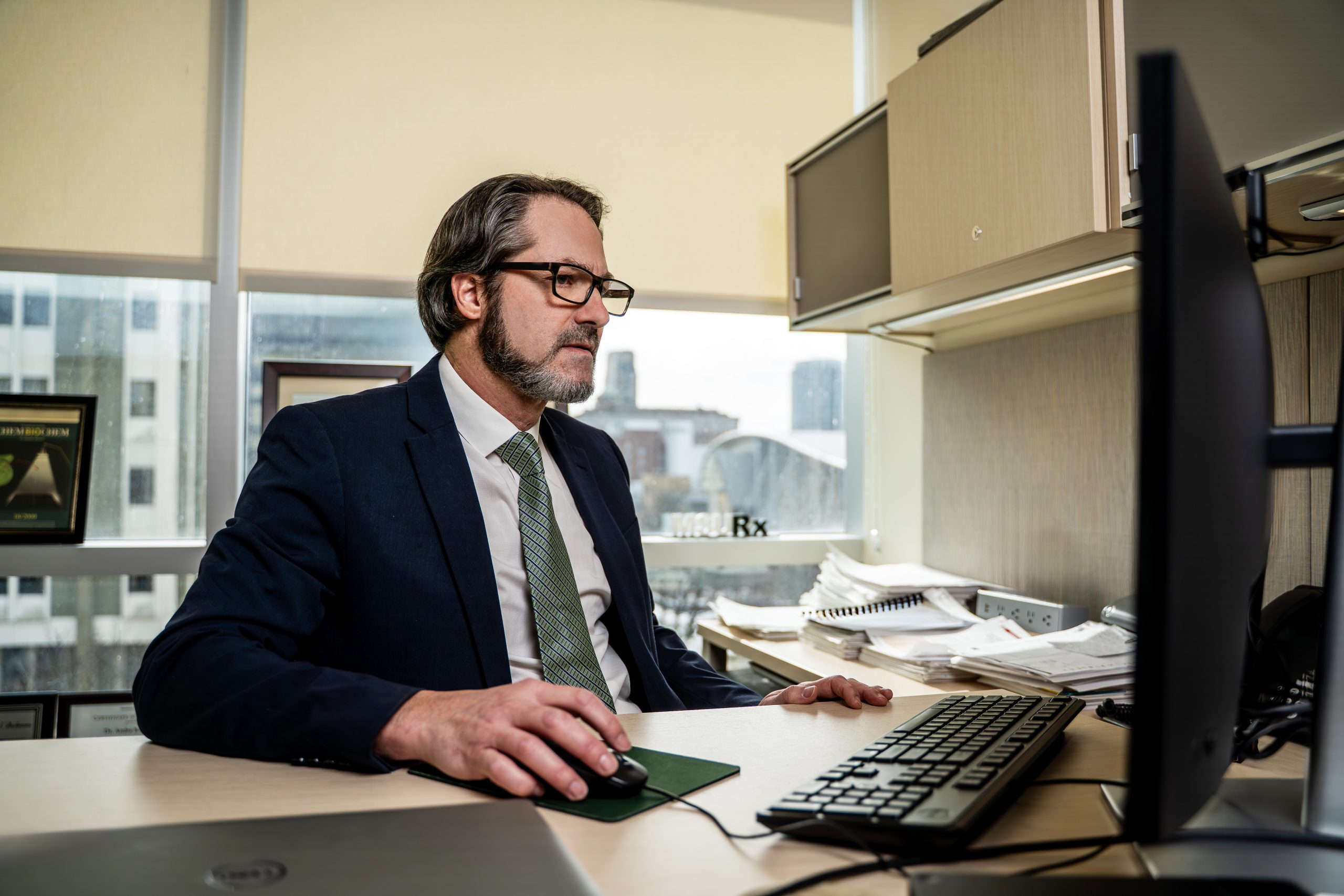Sometimes, there is serendipity in science when being in the right place at the right time can have dramatic, life-changing results. For Dr. André Bachmann, a pivotal moment occurred about a decade ago when he delivered a presentation on his genetic research at Helen DeVos Children’s Hospital in Grand Rapids.
Bachmann, a Professor of Pediatrics at Michigan State University (MSU) College of Human Medicine and Associate Chair for Research in the Department of Pediatrics and Human Development, has spent 30 years studying a particular protein-coding gene known as ornithine decarboxylase 1, or ODC1, and its mutations that sometimes lead to cancers and rare diseases.
A Rare Genetic Disorder Identified
In the audience that day was Dr. Caleb Bupp, Division Chief for Medical Genetics and Genomics at Corewell Health Helen DeVos Children’s Hospital. Bupp had been working with a young Kalamazoo patient who had an unidentified disorder. Since birth, she had struggled with body temperature and blood sugar regulation, an enlarged head, hair loss, skin lesions, and severe neurological challenges. A complete genetic sequencing revealed a mutation in ODC1—Bachmann’s area of expertise.

Unlike many genetic disorders, Bachmann hypothesized that this particular mutation in ODC1 led to excessive enzyme activity, causing an overproduction of polyamines. Fortuitously, a drug already approved by the FDA, Difluoromethylornithine (DFMO), had the potential to counteract this effect. Originally developed in 1978 and FDA approved in 1990 to treat West African sleeping sickness, DFMO was found to influence polyamine production. The FDA granted compassionate use authorization for Bupp’s patient, providing hope for families dealing with what is now called Bachmann-Bupp Syndrome.
“I don’t want to call it a miracle drug, but it really was remarkable,” says Bachmann. “These kids are significantly challenged neurologically—they can’t walk, they can’t talk, they can’t even sit on their own. When Dr. Bupp gave thatdrug to his first patient, she started to sit up straight. She was completely bald as part of this syndrome, and after about six months, she had a full head of hair. She’s been on the treatment for five years now, and she’s gained a lot of body strength and made huge overall improvements.”
From Discovery to Patents and Commercialization
Recognizing the potential impact, Bachmann and Bupp worked with MSU Technologies to secure patents on the use of DFMO, which are co-owned with Corewell Health, and are licensed to Orbus Therapeutics. This mid-sized biopharmaceutical company has the capability to manufacture and distribute the treatment.
“Without patents, these discoveries often are not further developed (or realized) and never reach patients,” Bachmann explains. “If you don’t patent your ideas, they will never end up in a clinic, and they will certainly not make it to an FDA-approved drug on the pharmacy shelf. It’s simply too expensive for academic institutions to bring a drug through the full FDA approval process-academic institutions cannot pay for that. Therefore, patents are needed to provide an incentive to pharma, or nothing will happen to the discovery that can help the patient.”
“Securing these patents requires extensive collaboration between researchers, physicians, and technology managers,” says Anupam Jhingran, MSU Senior Technology Manager, emphasizing the importance of this teamwork. “Collaboration between researchers and the physicians is instrumental in rare disease breakthroughs. There’s not a lot of money to support rare disease research in the pharma world, so partnerships like this are crucial for translating rare discoveries into treatments,” says Jhingran.
Unlocking the Possibilities of DFMO
Beyond its impact on what is now referred to as Bachmann-Bupp Syndrome (BABS), DFMO has also shown promise in treating neuroblastoma. This deadly pediatric cancer affects around 700 young children annually and accounts for 12% of childhood cancer deaths. In late 2023, the FDA approved DFMO for neuroblastoma treatment, with Phase II clinical trials indicating that it reduces the risk of relapse by 50%. Bachmann spearheaded the idea and use of DFMO in neuroblastoma with his preclinical investigations that commenced in 2002 and with participation in early phase I clinical trials. 
“It was very impressive that, despite being busy with his academic responsibilities, Dr. Bachmann would always find time to bring his ideas to our office and would make himself available for those discussions,” says Jhingran. “Once we secured the patent, Dr. Bachmann connected me with the team at Orbus and our office worked collaboratively with the team at Orbus to license his patents.”
“This is why I do what I do,” Bachmann reflects. “My goal is to help people, and it can’t get any better than that. Of the 17 BABS patients worldwide to date, we now have six patients with BABS who are all being treated with DFMO. You never want to create false hope, but when there’s a real chance to help, it’s just so energizing when you can actually help these parents and their children.”
A Promise of More Innovation to Come
Bachmann has since co-founded the International Center for Polyamine Disorders, a collaborative venture between MSU and Corewell Health West Michigan. In the future, he hopes to explore 15 related genes along the same pathway as ODC1, building upon his research, hoping to unlock treatments for other neurodevelopmental disorders.
“This is the only center worldwide dedicated to polyamine disorders,” Bachmann notes. “We work with patients globally, collecting and analyzing blood samples at Corewell Health that then are analyzed in my lab. I’m really proud, but it couldn’t have been done alone. None of this would be possible without a dedicated interdisciplinary team of scientists, physicians, nurses and other dedicated staff.”
In recognition of his groundbreaking work, Bachmann and Bupp have received numerous accolades, including the 2023 Inventor of the Year Award from the New York Intellectual Property Law Association. In 2024, Bachmann was inducted as a Senior Member of the National Academy of Inventors and has now been honored as MSU’s Innovator of the Year.
Though his work has been widely celebrated, Bachmann remains gracious and humble, acknowledging the many wonderful people who have worked by his side to develop these groundbreaking treatments, emphasizing the role of collaboration—and a bit of luck.
“It’s definitely unusual that somebody who just had a patient with an undiagnosed rare disorder related to your research just happens to be in the same seminar room,” he says. “But it also shows that you need to go to seminars and listen to people talking, because frankly, we don’t always have time to go. Dr. Bupp works up the street from me, and we may have never met if he hadn’t attended that seminar and his clinical colleague Dr. Rajasekaran, a pediatric ICU doctor had not made the formal introduction after the seminar. It reminds us why we should always engage with our colleagues and listen to new ideas. You never know what breakthrough might come next.”
Is your company interested in partnering with any of MSU’s expansive team of healthcare experts? Click Here.
About the MSU Innovation Center:
The MSU Innovation Center combines research partnerships, technology transfer, and startup support for MSU faculty who aim to see their research applied to make the world a better place.
Composed of Business Connect, MSU Technologies, and Spartan Innovations, the MSU Innovation Center aims to amplify the impact of faculty research and drive economic growth while positively impacting society to solve real-world challenges with cutting-edge ideas.
Through mutually beneficial, long-term partnerships with the private sector, we connect MSU faculty with companies for corporate-sponsored research collaborations. We also play a key role in facilitating the commercialization and public use of technologies and copyrightable materials, moving MSU’s innovations from the lab to the marketplace. Importantly, we provide significant support for faculty entrepreneurs in establishing startup companies based on technologies developed at MSU.
